Safer Spaces for UARK Students: Integration at the University of Arkansas
Introduction
Text-to-speech Audio
Images
Negroes at UA Ask U.S. [Court] to End Discrimination
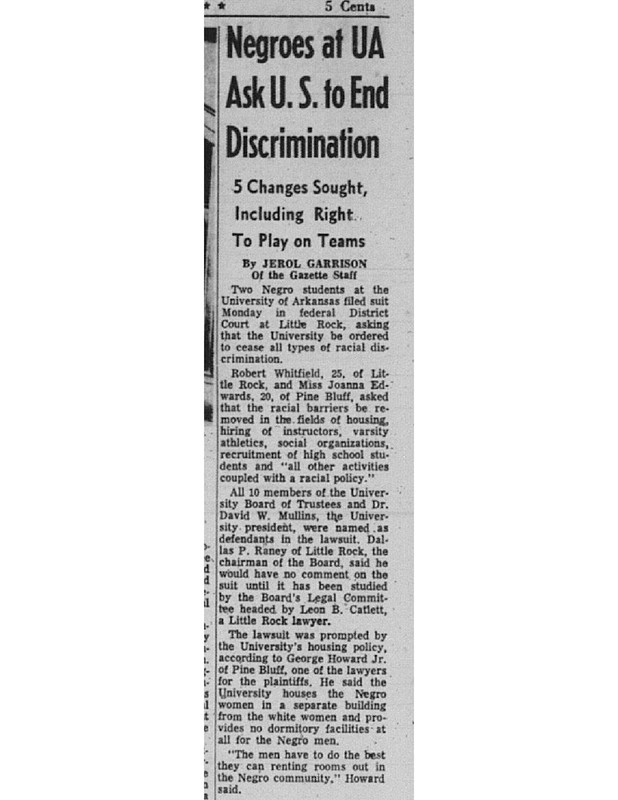
Negroes at UA Ask U.S. [Court] to End Discrimination
![Negroes at UA Ask U.S. [Court] to End Discrimination](https://storage.googleapis.com/clio-images/medium_2339_ViewScan_0001-page-002.jpg)
Negroes at UA Ask U.S. [Court] to End Discrimination
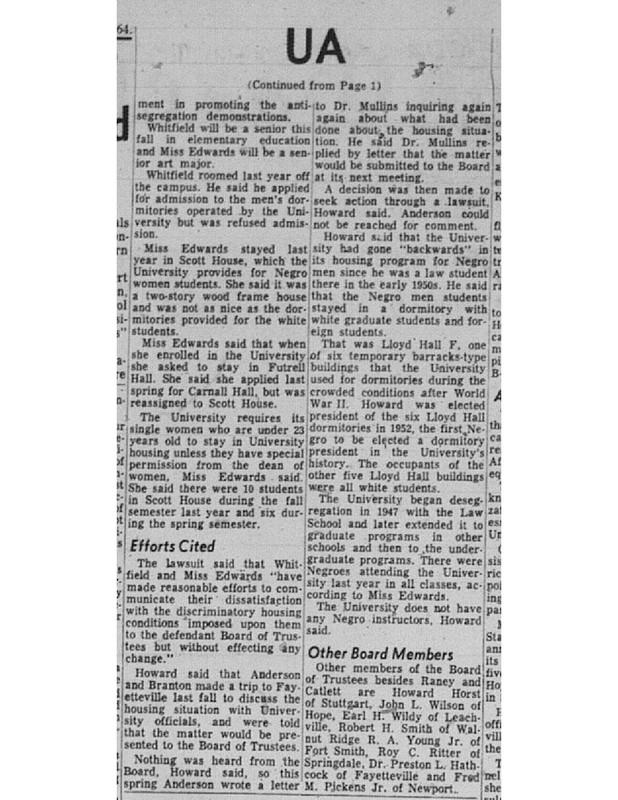
2 Negroes Tell Why They Seek UA Integration
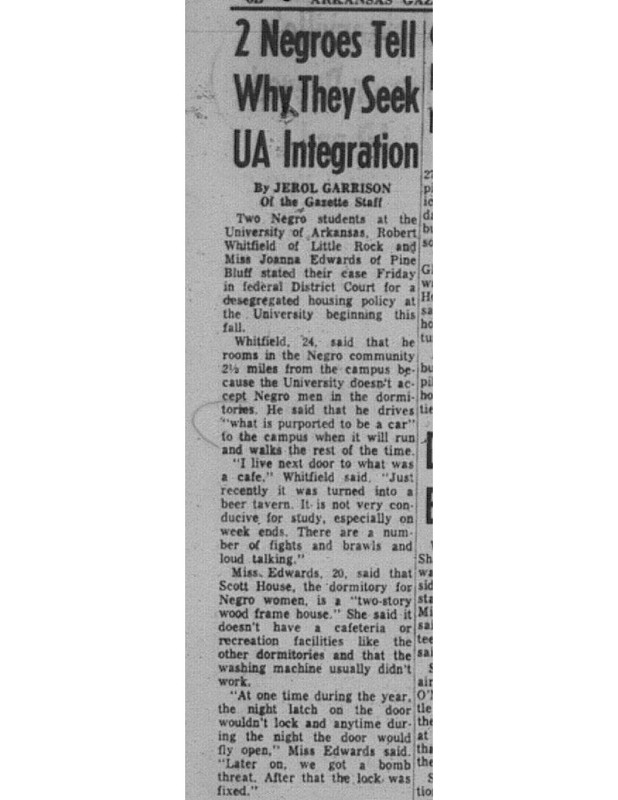
2 Negroes Tell Why They Seek UA Integration
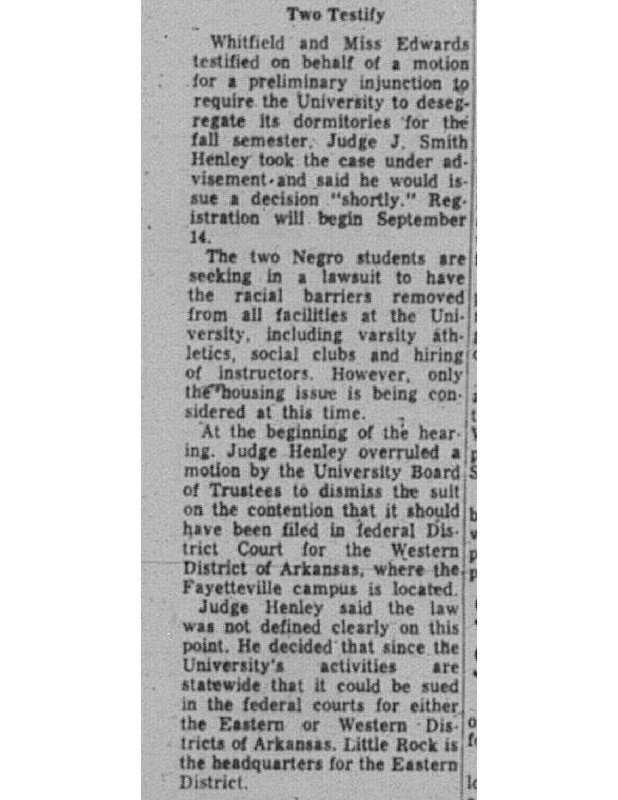
2 Negroes Tell Why They Seek UA Integration
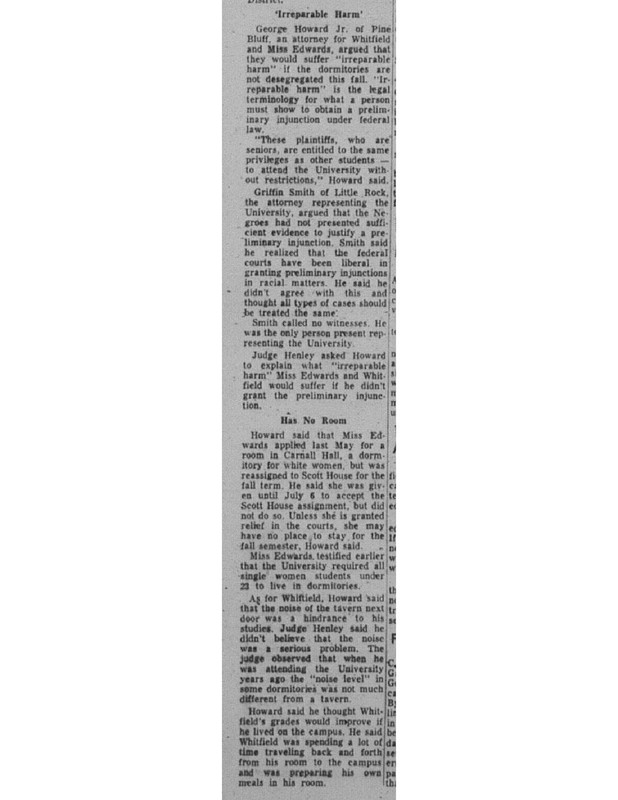
George Howard
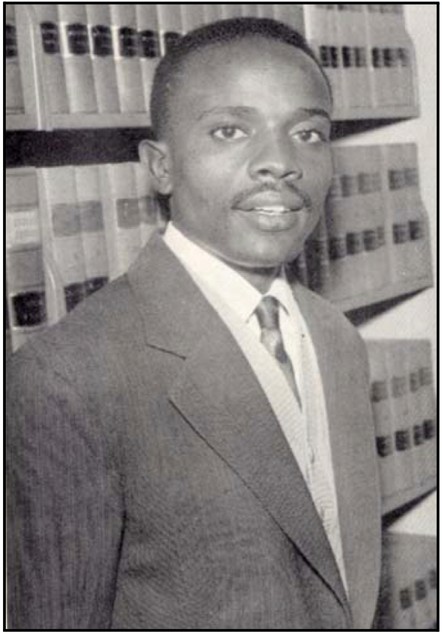
Backstory and Context
Text-to-speech Audio
Access to on-campus housing was not available to the first several Black students admitted to the University of Arkansas. After being admitted the the law school, the landmark "pioneers" were urged to seek housing with Black families in the community rather than press for on campus housing. In the spring of 1951, law student George Howard became the first student to be admitted to University of Arkansas housing (Kilpatrick). This move, however, was not intentional. Campus housing authorities were not aware that Howard was Black until he arrived on campus and submitted his certificate for campus housing. Howard was joined in Lloyd Hall by two fellow law students, George Haley and Christopher Mercer, the following semester. The housing of these students in university dormitories was an exception to university rules rather than an institutional change.
Howard went on to push for this institutional change, representing two University of Arkansas undergraduate students in a 1964 case to pursue integration of University of Arkansas dormitories (Garrison). This movement was supported by several on-campus protests such as one detailed by the Arkansas Traveler where 10-15 University of Arkansas picketed in front of the Arkansas student union, calling for the end of housing discrimination on the University of Arkansas campus. At the time this article was written, Black women were housed in a separate dorm and Black men had no on campus housing options (Pickets March for Negro Rights). The dorms were officially integrated in 1964.
The integration of dorms did not ensure a welcoming environment for Black students choosing to take advantage of this new opportunity and most faced a variety of different forms of discrimination. The students who were a part of the Black Americans for Democracy had many harsh experiences with discrimination while living on campus and it was commented on frequently in The BAD Times newspaper. One article concerning the living conditions in Hotz Hall (Sprinkle) provides an insightful look at the psychological aspects of living with individuals who believe you to be inferior.
Discrimination within housing continued to play an impactful role in the experience of Black students long past the BAD Times movement. Angela Mosley-Monts, a student at the University of Arkansas from 1976-1979 recounts that many students requested a new room after discovering that their randomly assigned roommate was Black. Mosley-Monts' experienced this herself when her first roommate, a white woman, immediately asked to have her room changed upon arriving at the university. Other experiences of discrimination for Mosley-Monts include having her hair products repeatedly stolen while she was in the shower and being greeted with racial slurs after leaving the door to her room open while watching the movie “Roots” with a group of friends. On another occasion in 1977 when Ms. Mosley-Monts went to pick up her brother from Pomfret, a white man in the parking lot repeatedly stood in every spot she tried to park in. One of her brother’s fraternity brothers watched the incident and confronted the man who hurled insults at them in response, eventually leading to a fight. Mosley-Mont's experiences were not unique and represent the experiences of many Black students living on the University of Arkansas campus in the 1970s and 1980s.
Black students living on campus today still encounter various forms of discrimination but University Housing is working hard to create appropriate mechanisms to address and prevent this discrimination. Ms. Mosley-Monts believes that current housing administrators do an excellent job of making sure that students have a sense of community within residential halls through programming and education. They also currently make sure to have minority RAs who residents can feel comfortable going to in situations of discrimination or if they want to talk to someone with similar shared experiences. All RAs also go through diversity, equity and inclusion training.
Megan Rodgers is a senior Honors College Fellow from Siloam Springs, Arkansas, who is majoring in international studies, political science and Spanish at the University of Arkansas. Her interests focus on the topic of peace building and she is currently the vice-president of Students with Refugees at the University of Arkansas and the co-student director of STAND: the student-led movement to end mass atrocity. After graduation, Megan plans to pursue a master’s degree in conflict resolution and dedicate her career to leading the U.S. support of peace building initiatives both domestically and abroad.
Sources
Sprinkle, Harold. “The Hotz Experience". March 1972. BAD Times. BAD Times Collection: A Digital
Collection of the Black Americans for Democracy Newspapers.” Special Collections, University of
Arkansas Libraries, Fayetteville, October 2015.
http://digitalcollections.uark.edu/cdm/landingpage/collection/BADTimes
Garrison, Jerol. “2 Negroes Tell Why They Seek UA Integration,” Arkansas Gazette, September
5, 1964, p. 6B
Garrison, Jerol. “Negroes at UA Ask U.S. [Court] to End Discrimination,” Arkansas Gazette,
August 18, 1964, p. 1
Kilpatrick, Judith. (2009). Desegregating the University of Arkansas School of Law: L. Clifford
Davis and the Six Pioneers. The Arkansas historical quarterly. 68. 123-156.
Mosley-Monts, Angela. Personal Interview. 5 November 2020.
“Pickets March for Negro Rights: 'Students for Freedom' Protest Against UA's Alleged Housing
Discrimination,” Arkansas Traveler, December 18, 1962. Vol. 57, no. 51
Garrison, Jerol. “Negroes at UA Ask U.S. [Court] to End Discrimination,” Arkansas Gazette, August 18, 1964, p. 1
Garrison, Jerol. “Negroes at UA Ask U.S. [Court] to End Discrimination,” Arkansas Gazette, August 18, 1964, p. 1
Garrison, Jerol. “Negroes at UA Ask U.S. [Court] to End Discrimination,” Arkansas Gazette, August 18, 1964, p. 1
Garrison, Jerol. “2 Negroes Tell Why They Seek UA Integration,” Arkansas Gazette, September 5, 1964, p. 6B
Garrison, Jerol. “2 Negroes Tell Why They Seek UA Integration,” Arkansas Gazette, September 5, 1964, p. 6B
Garrison, Jerol. “2 Negroes Tell Why They Seek UA Integration,” Arkansas Gazette, September 5, 1964, p. 6B
From the 1953 Razorback. Courtesy Special Collections, University of Arkansas Libraries, Fayetteville
